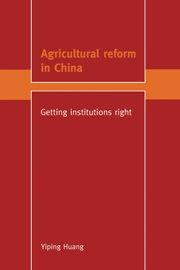Book contents
- Frontmatter
- Contents
- 1 List of figures
- 2 List of tables
- Acknowledgements
- 1 Getting markets to work in the countryside
- 2 Institutional distortions in pre-reform agriculture
- 3 Getting farmers back to work
- 4 Getting prices right
- 5 Adjustments in rural markets bring structural change
- 6 An agricultural economy without freedom to trade
- 7 China's agricultural policy choices
- 8 Chinese farmers can adapt
- 9 Getting reform right in agriculture
- Appendix: The China model
- References
- Index
Appendix: The China model
Published online by Cambridge University Press: 18 June 2010
- Frontmatter
- Contents
- 1 List of figures
- 2 List of tables
- Acknowledgements
- 1 Getting markets to work in the countryside
- 2 Institutional distortions in pre-reform agriculture
- 3 Getting farmers back to work
- 4 Getting prices right
- 5 Adjustments in rural markets bring structural change
- 6 An agricultural economy without freedom to trade
- 7 China's agricultural policy choices
- 8 Chinese farmers can adapt
- 9 Getting reform right in agriculture
- Appendix: The China model
- References
- Index
Summary
Sector details
One important decision in computable general equilibrium modelling is the degree to which production is disaggregated. This is a crucial determinant of a model's potential usefulness in policy analysis. Disaggregation and detailed sector structure are distinctive features of computable general equilibrium models, particularly when they are compared with macroeconomic models. This China model uses detailed agricultural sector data, since the primary interest lies in the impact of incentive distortions on the sector as a whole and on individual farm commodities. Grain (rice and wheat), cotton and wool are distinguished from other products. Disaggregation does not come without cost, however. A detailed model structure provides insights into structural change, but demands higher quality inputs. Computable general equilibrium models are built on parameters and coefficients characterising economic agents’ behaviour. Data availability (for both input–output parameters and behavioural elasticities) is therefore important in determining the model's structure. In view of the limited resources available, non-agricultural sectors are treated at an aggregated level. In combining individual industrial sectors, attention is given to distinguishing export-oriented and import-competing industries (Clarete and Warr 1992) and to separating activities that use different production techniques (input combinations) (NCDS1990).
The China model contains twenty-two sectors, of which four are agricultural and eighteen are non-agricultural (table A.I). Agriculture is of particular interest in this study. About two-thirds of the value of agricultural production comes from food and other crop production. Over half of this is in the production of food crops including rice, wheat and other grain crops. A further quarter of the value of agricultural output comes from livestock production which produces wool and non-wool animal commodities.
- Type
- Chapter
- Information
- Agricultural Reform in ChinaGetting Institutions Right, pp. 171 - 191Publisher: Cambridge University PressPrint publication year: 1998

